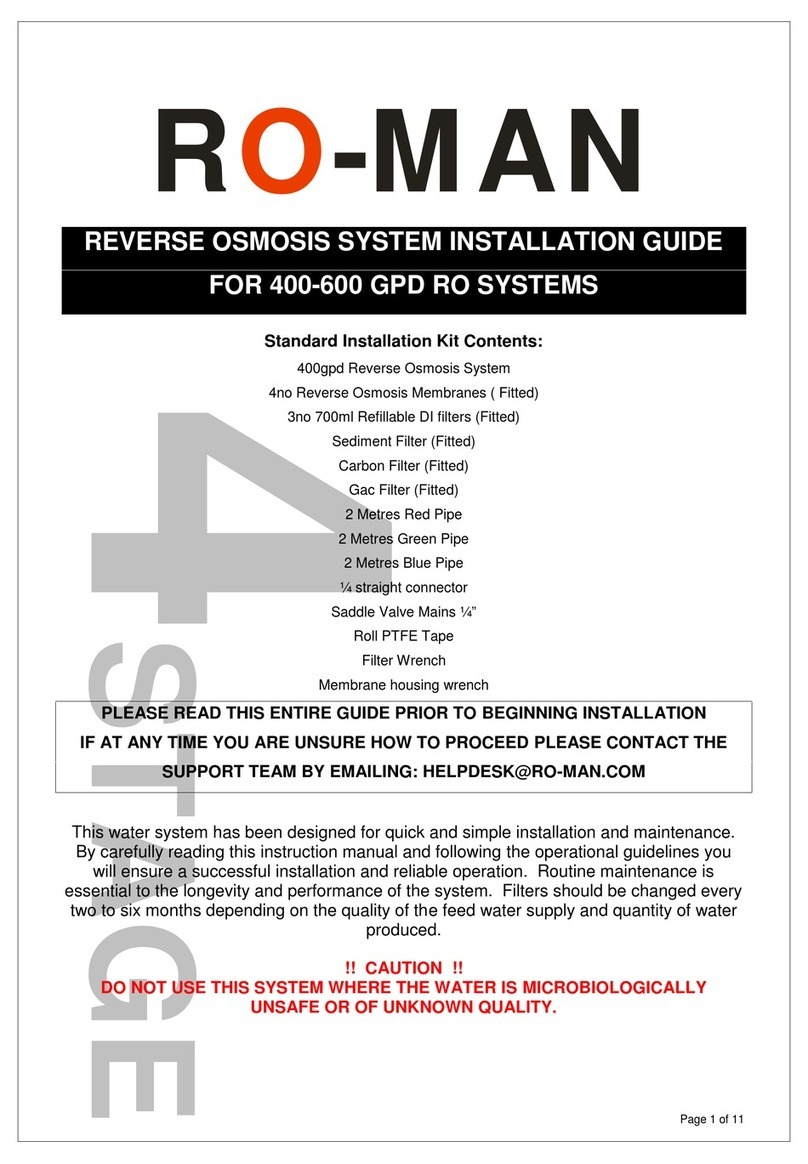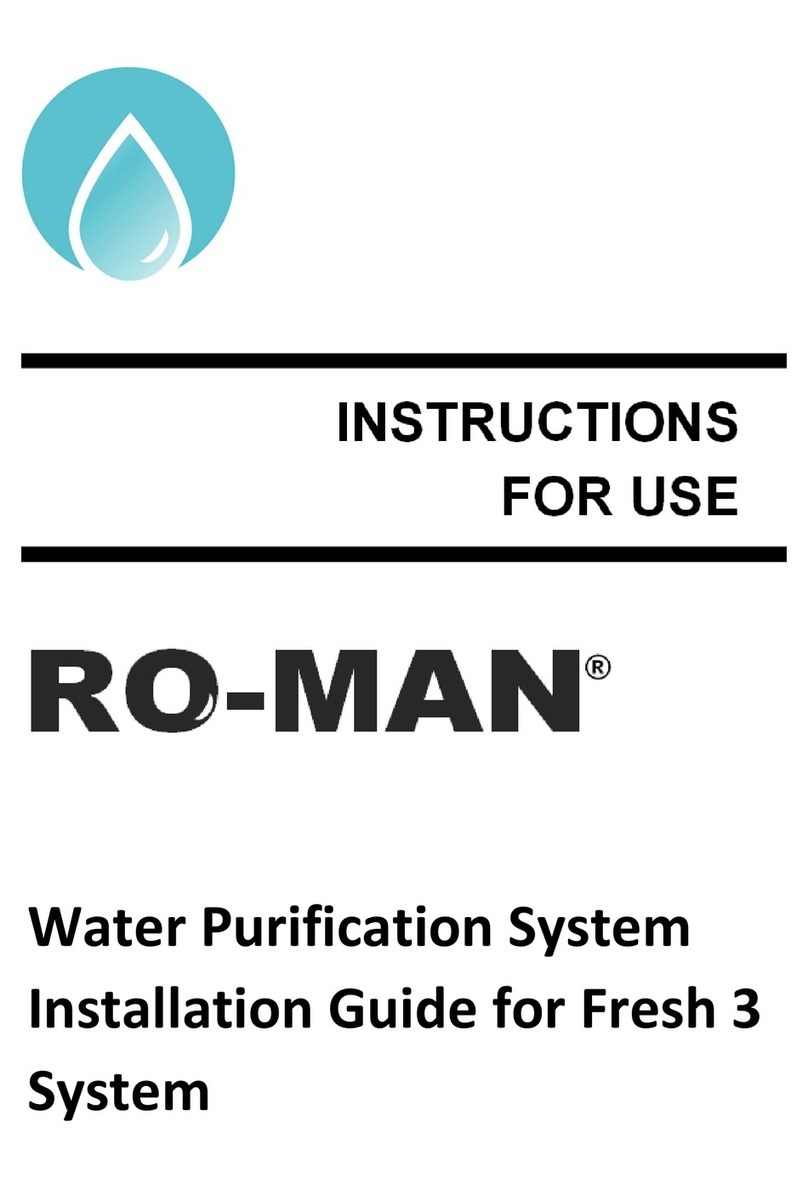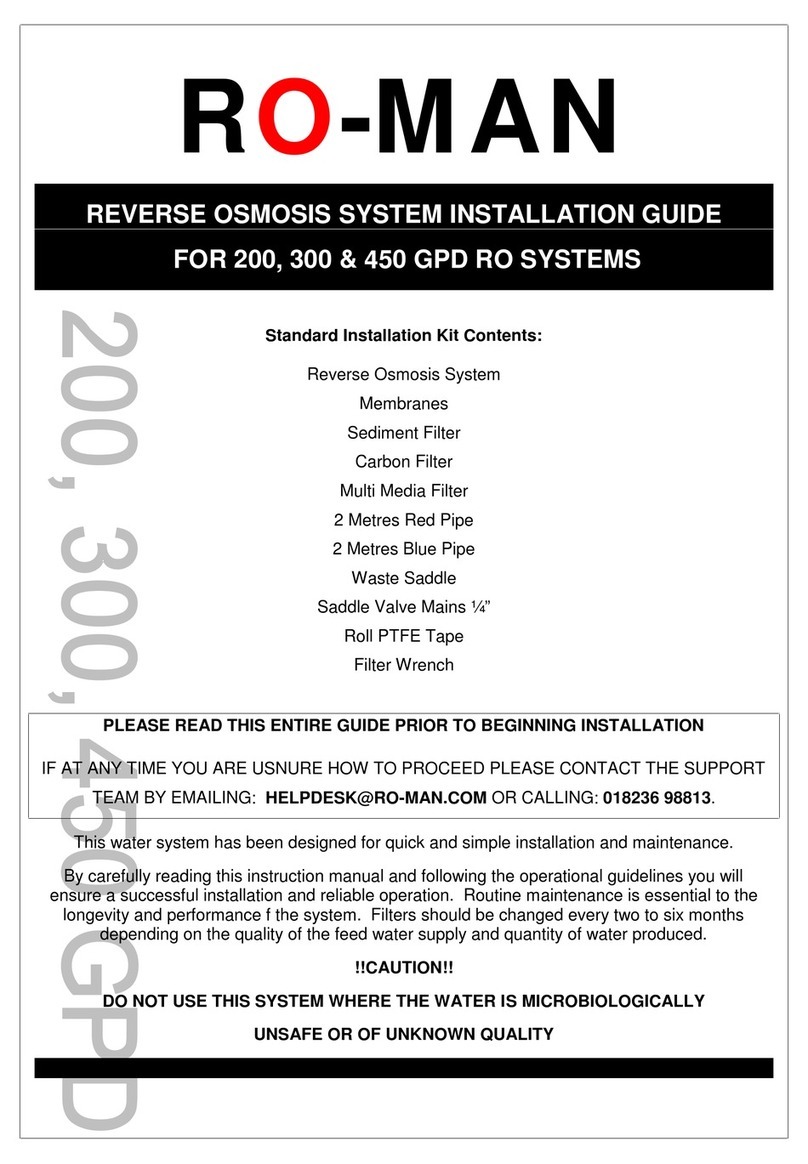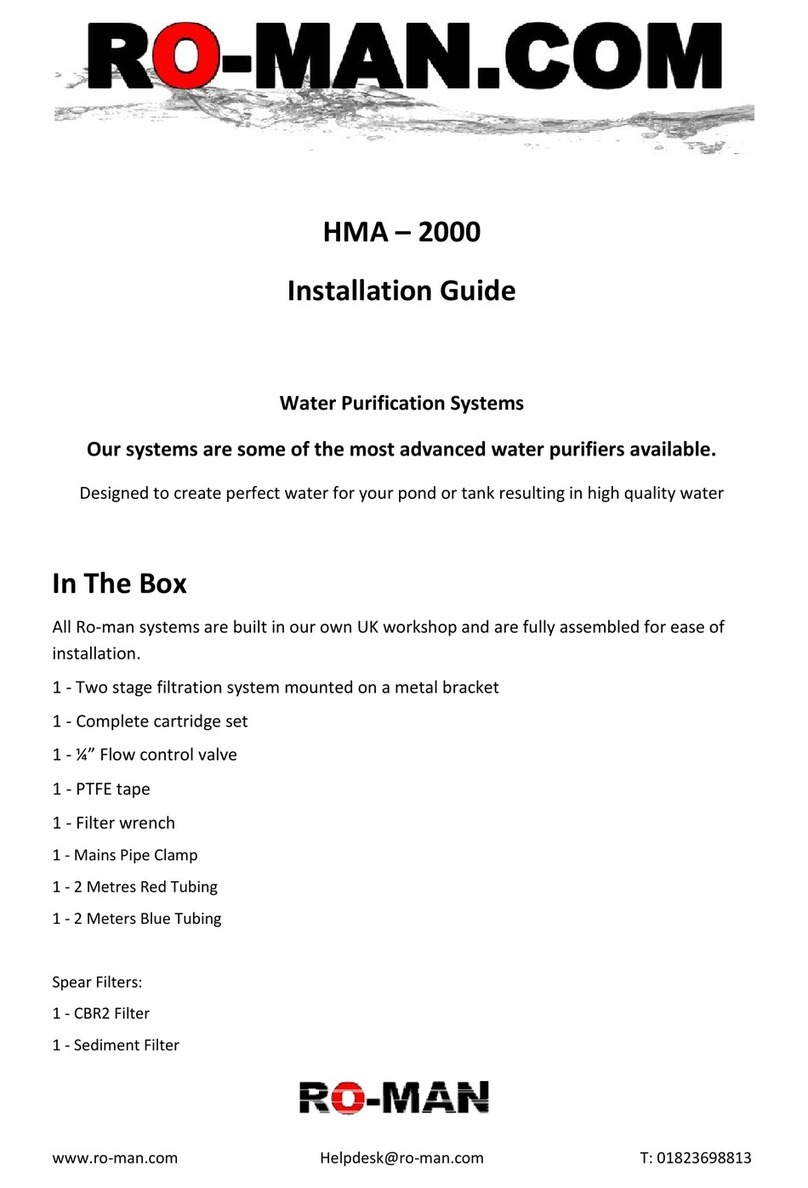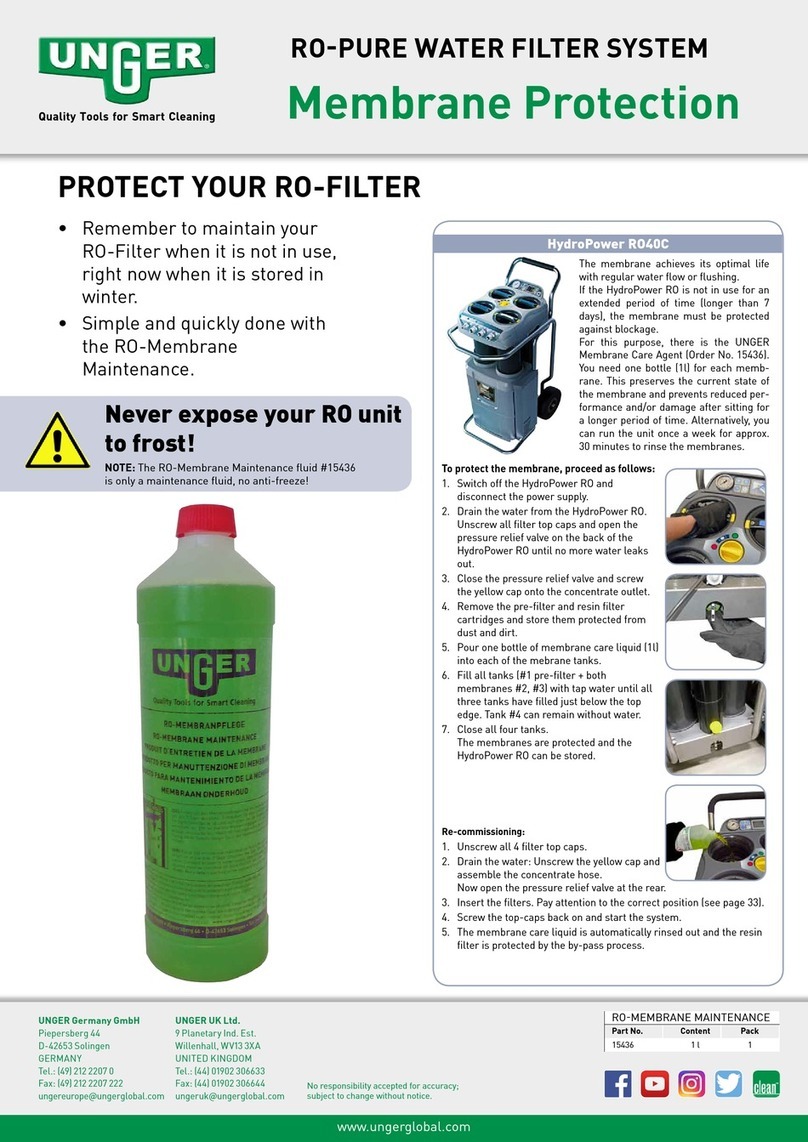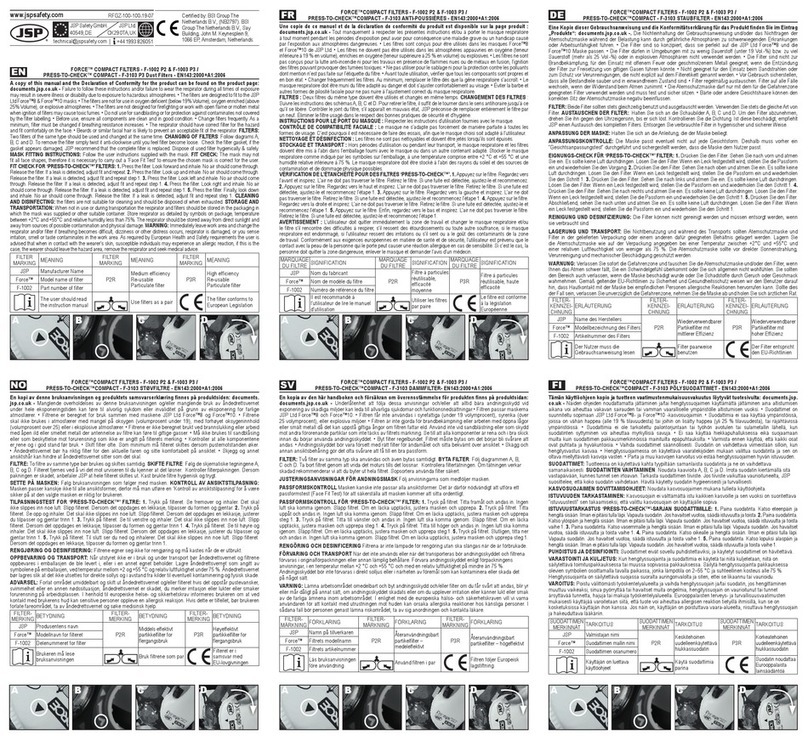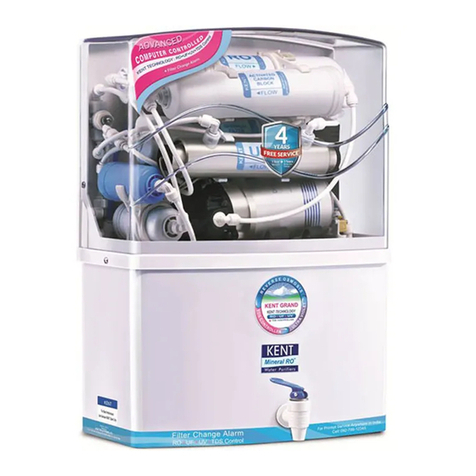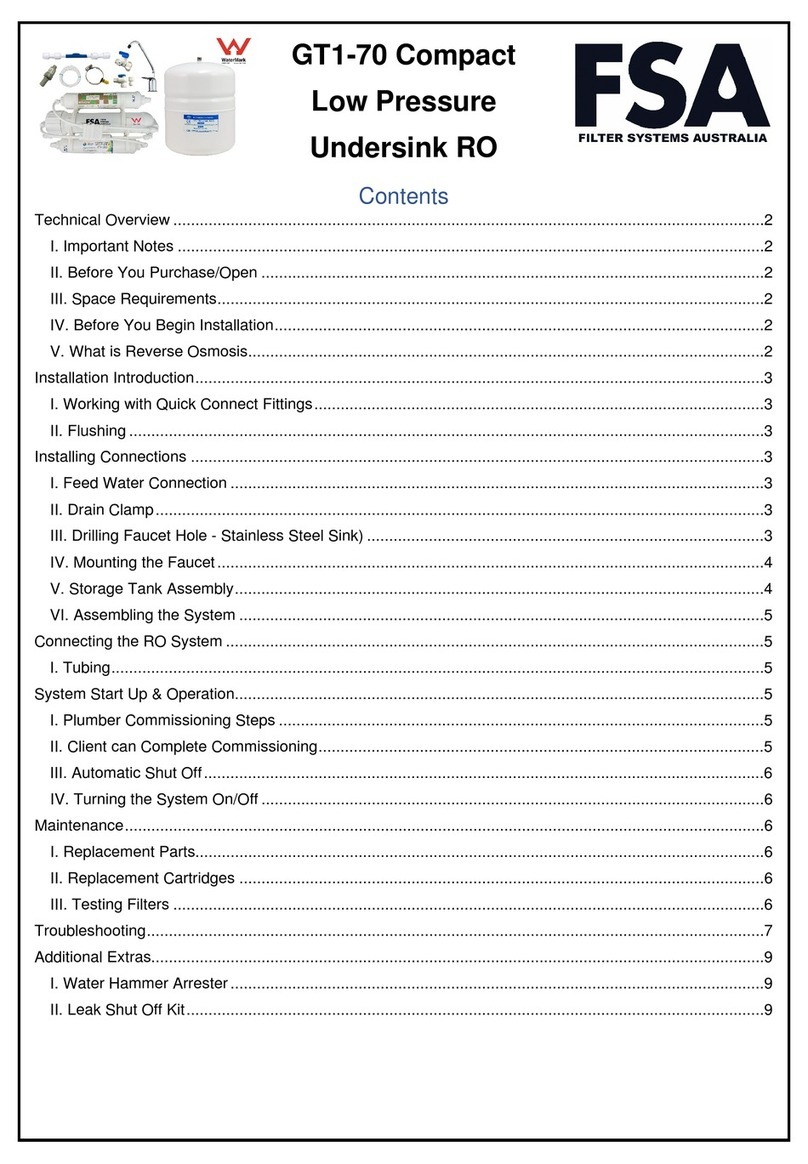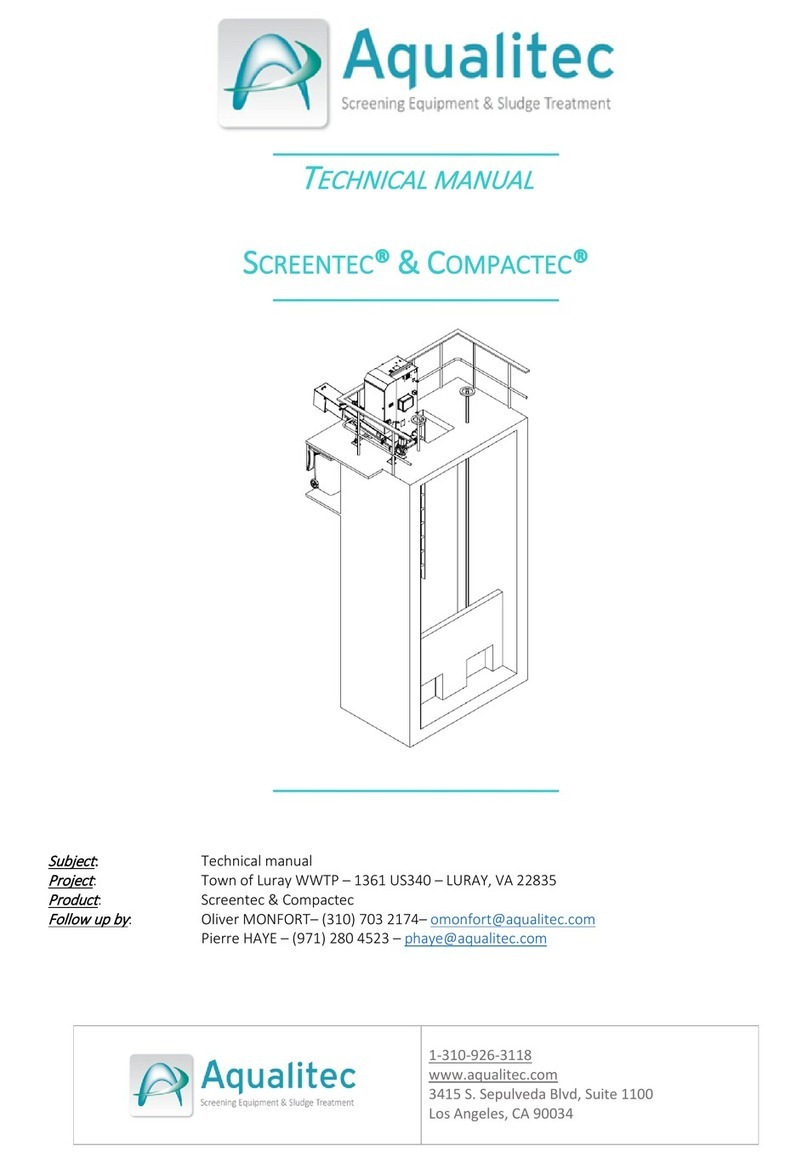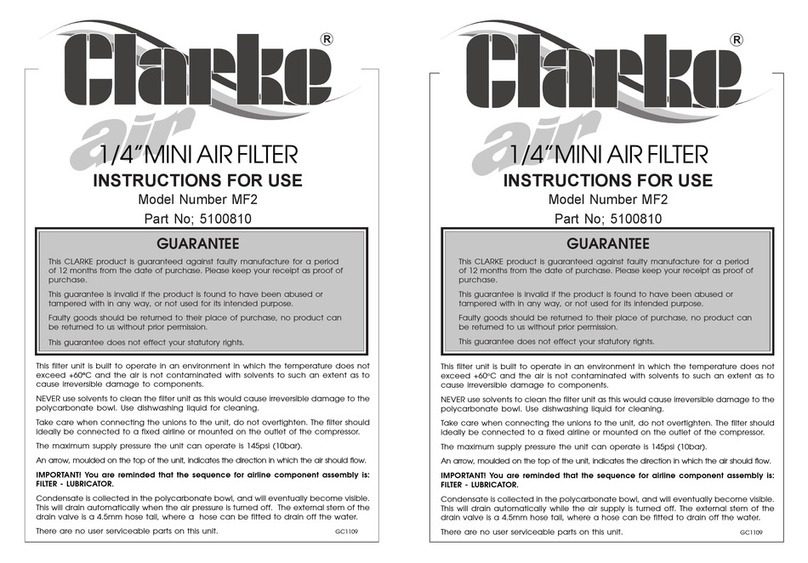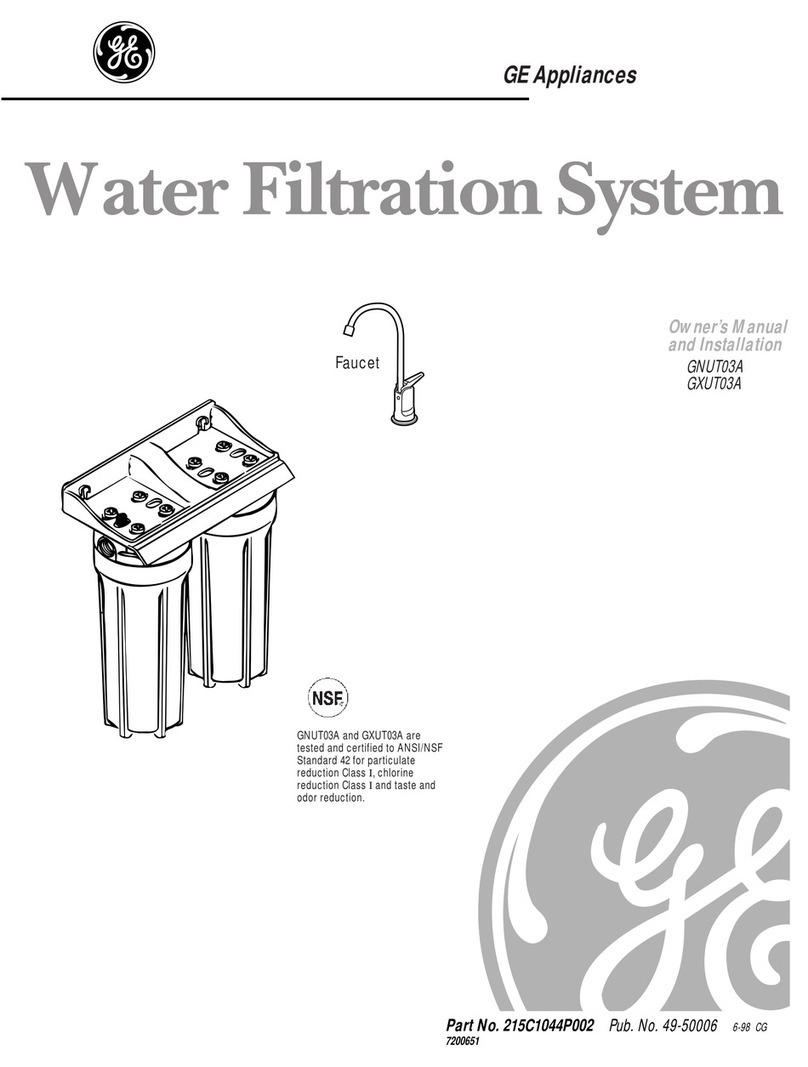Ro-Man 3 Stage Standard User manual

Reverse Osmosis Systems
RO-MAN
®
INSTRUCTIONS
FOR USE

2
RO-MAN®
Contents
Page No.
What’s in the Box 3
How Reverse Osmosis Works 4
Schematics 5
Before you Begin 7
Planning 7
Installing Supply Feed 8
Installing Sink Top Faucet 9
Installation of Drain Saddle 9
Installation of Storage Tank 9
Mounting the Unit Assembly 9
Fitting the Membrane 10
Fitting the Pipes 11
Flushing the Carbon Filters 12
Fitting the Pipes for Production 12
Flushing the Filters 13
Flushing the Membrane 13
Connecting the DI Unit 13
Startup Procedure 13
Turning off your RO System 14
Maintenance 14
Conditions for Operation 15
Nominal Rejection Characteristics 15
Membrane Performance 16
Net Pressure Correction 16
About TDS 17
Common Problems 18
RO-MAN Options 19
Manufacturer Information 19

3
RO-MAN®
What’s in the Box
Large
Systems
3 Stage
Standard
4 Stage
Standard
4 Stage
Pro
200, 300 &
450 GPD Domestic Dental
Reverse Osmosis Membrane PPPPPP
Sediment Filter PPPPPP
Carbon Filter P P x2 P P x2 Px2 P
Inline Carbon P
Re-mineralising Filter P
DI Filter P P
2 Metres Red Tubing PPPPPP
2 Metres Green Tubing PPPPPP
2 Metres Blue Tubing PPPPPP
Waste Saddle PPP
Connection of Choice PPPPPP
Faucet Tap P P
Storage Tank P P
Tank Valve and Y Splitter P P
Roll PTFE Tape PPPPPP
Filter Wrench PPPPPP
3
/ST
4
/ST
4
PRO

4
RO-MAN®
How Reverse Osmosis Works
Reverse Osmosis (RO) is one of the most convenient and effective filtration methods available. Reverse
Osmosis membranes can usually remove between 96% and 99% of most contaminants, including salts and
minerals, dyes, particles, bacteria and hazardous metals.
Simply put it is the process of osmosis backwards. Osmosis is the passage of water through a protein
membrane to equalize the concentration of particles dissolved in the water. The membrane allows water to
pass through however larger molecules like minerals, salts and bacteria cannot. In osmosis, water flows
back and forth until the concentration is equal on both sides of the membrane. By using pressure, the water
is forced to move away from the membrane rather than attempting to form an equilibrium like normal. This
against-flow motion is where the “reverse” in Reverse Osmosis comes from.
In Reverse Osmosis, the process works by separating contaminants from water by forcing the water
through a semi-permeable membrane. This membrane acts as a physical barrier to almost all molecules
with a molecular weight greater than 200 grams/mole. This membrane is rated at 0.0001 micron which
equals to 0.00000004 inch. For example, the membrane may allow passage of water molecules, but blocks
molecules of dissolved salt. Unwanted molecules are retained by the membrane while the ultra-pure water
continues on for use or further treatment. This is the same technology used to make bottled water and is
the only technology capable of desalinating sea water to be made into drinking water.
Non-RO water filters are much less effective with a larger pore size on these filter media, normally
between 0.5 – 10 micron. They can only filter out coarse particles, sediments and elements up to their
micron rating. Anything finer, as well as most dissolved substances, cannot be filtered out. As a result
water is a lot less clean and safe compared to reverse osmosis filtration.

5
RO-MAN®
Schematics
4 Stage Professional System
Ball
Valve
Flow Restrictor
DI
Unit
Carbon
Filter
Sediment
Filter
Membrane
Pressure
Gauge
SUPPLY PRODUCT
WASTE
In Flush Mode
Ball
Valve
Flow Restrictor
Carbon
Filter
Sediment
Filter
Membrane
Pressure
Gauge
SUPPLY PRODUCT
WASTE
In Flush Mode
3 Stage Standard System
4 Stage Standard System
Ball
Valve
Flow Restrictor
Carbon
Filter
Sediment
Filter
Membrane
Pressure
Gauge
SUPPLY PRODUCT
WASTE
In Flush Mode
Carbon
Block
3
/ST
4
/ST
4
PRO

6
RO-MAN®
6 Stage Drinking Water System
Ball
Valve
Flow Restrictor
GAC
Filter
Sediment
Filter
Membrane
Pressure
Gauge
SUPPLY
PRODUCT
WASTE
In Flush Mode
Carbon
Filter
Taste & Odour Remineraliser
Storage
Tanks
Faucet
Tap
Valve
Dental System
Ball
Valve
Flow Restrictor
DI
Unit
Carbon
Filter
Sediment
Filter
Membrane
Pressure
Gauge
SUPPLY
WASTE
In Flush Mode
PRODUCT
Storage
Tanks
Faucet
Tap
Valve
200/300/450 GPD System
Ball
Valve
Flow Restrictor
Carbon
Filter
Sediment
Filter
Membrane
Pressure
Gauge
SUPPLY PRODUCT
WASTE
In Flush Mode
Chlorplus
Filter
Membrane
Large
Systems

7
RO-MAN®
Before you begin
This water system has been designed for quick and simple installation and maintenance. If preferred, a
local plumber can install the system for you. Please read this entire guide prior to beginning installation. If
By carefully reading this instruction manual and following the operational guidelines you will ensure a
successful installation and reliable operation. Please keep in mind which system you have as some
sections may not apply to you.
Routine maintenance is essential to the longevity and performance of the system. Filters should be
changed every two to six months depending on the quality of the feed water supply and quantity of water
produced.
Important: this system is not designed for use where the water is microbiologically unsafe
or of unknown quality.
Planning
ŸDetermine the location for the installation of the system. Avoid locations where the system might come
in contact with hot water pipes, other hazards or exposed to extreme cold. (RO membranes can be
damaged by frost.) This system may be mounted in either a vertical or horizontal position and must be
positioned to allow access for servicing and filter cartridge changing.
ŸDetermine the location for the discharge of the waste water.
ŸDetermine the location of the cold water pipe. To assure you are using the cold water line, turn on both
the hot and cold tap. After the water is warm to the touch, carefully feel the pipes under the sink. It will
be easy to identify the hot and cold pipes.

8
RO-MAN®
Installing Supply Feed
ŸLocate the water shut-off valve for the cold water feed line of your mains supply and shut off the water.
ŸAccidentally hooking up the system to the hot supply line will permanently damage the membrane (See
conditions for operation).
ŸClose the cold water valve. Turn on the cold water tap only to assure that the line is completely shut off
and the line is drained. If no shut off valve is located under the sink, turn off the main supply at the entry
to the house.
ŸBefore fitting the saddle clamp to the cold water supply ensure that the valve is fully open i.e. when
looking down the wing nut is turned anti clockwise as far as it will go (don’t force it).
ŸNow fit the saddle valve to the 9 or 15mm copper cold water supply pipe ensuring that the spacer is
fitted closely to the pipe, then tighten the lower bolt with a spanner. You can now connect the red ¼”
pipe, which will feed the RO system, by simply pushing it into the saddle valve as far as it will go and
then gently pulling back to ensure that it is gripped securely.
Remember when you are ready to feed water to the RO system turn the wing nut fully clockwise which will
cause a spike to be driven into the copper pipe and then anti clockwise to start the flow of water.
Important: do not use this valve on a regular basis to turn the system on and off, a ball valve should
be used for this.
Wing Nut
Saddle Clamp
Spacer
Bottom Nut
Red Pipe
TO RO UNIT

9
RO-MAN®
Installing Sink Top Faucet (If Supplied)
ŸUsing a VSR drill with a carbide grinding burr, gently grind away enough porcelain or enamel to more
than accommodate the drill bit (about 18mm). Enough surface material must be removed to expose the
base metal.
ŸUsing the 1/4" drill bit, drill a 1/4" hole through the base metal. Operate the drill slowly and carefully,
especially when the drill is about to penetrate the metal.
ŸRepeat this step again using the 1/2" drill bit.
ŸMount the sink top faucet in the hole and using an adjustable wrench to hold the faucet, tighten the
9/16" nut.
Installation of Drain Saddle (If Supplied)
ŸPosition as far away from garbage disposal as possible.
ŸThe drain saddle should be installed above the p-trap on the vertical or horizontal
tailpiece.
ŸDrill a 1/4" hole into the drain pipe observing the above position.
ŸMount drain saddle aligning holes (drill bit may be left in saddle hole for alignment).
ŸCarefully tighten both screws on drain saddle until snug. Do not over tighten.
Installation of Storage Tank (If Supplied)
ŸWrap 5 to 7 winds of PTFE tape around metal tank threads.
ŸHand tighten plastic shut-off valve to tank until firm but not over tight.)
ŸTank should come from the factory with 8 to 14 lbs. PSI of air when measured empty.
Mounting the Unit Assembly
ŸMounting the unit is optional. Determine if this is a necessity before proceeding.
ŸMark screw locations at the desired positions. Use the two holes on back of assembly mounting bracket for
marker guides.
ŸScrew wood screws with unit into marked positions. Leave screw heads out a little.
ŸMount unit assembly onto screws.
3 Stage Standard, 4 Stage Standard, 4 Stage Professional

10
RO-MAN®
Fitting the Membrane/s
ŸRemove the membrane from packaging.
It is important not remove the white sticky tape or the plastic wrapping from around the membrane.
ŸIt is recommended that both the two small black o-rings and the large black O ring are given a VERY light smear
of petroleum jelly such as Vaseline to make installation easier.
ŸHolding the housing, unscrew the housing cap complete with pressure gauge and insert the membrane with the
two small, black o rings first. It will stop at the large black gasket seal located on the outer edge of the membrane
material. Push the membrane into the housing sometimes it’s a tight fit so push with adequate force. You will feel
it “seat” into the housing.
ŸOnce the membrane is seated properly, make sure the housing “o ring” is fitted and moist. Then screw the
housing cap onto the housing.

11
RO-MAN®
Fitting the Pipes
The Push Fit Connectors are opened by pushing down on the collet ring and pulling the hose at the same
time. If you prefer you can use a pair of pliers, a small
spanner or any tool that can apply pressure on both side of
the quick connect collet.
A. Red Pipe: Connects the water supply connector
After cutting the red pipe to a suitable length connect it to the
red capped inlet of your Sediment Filter housing found at the
top right of the RO unit and marked with an up arrow and the word “IN”. Do NOT turn the water on yet!
B. Blue Pipe: Connects y fitting to the sink top faucet
This can be connected to the outlet of the DI Unit and the other end to your point of use. Bear in mind that
you will have to discard the first 2 gallons from this pipe.
C. Green Pipe: Connects to the drain saddle
One end of this to be attached to a suitable waste water discharge point, typically this will be a 36mm white
plastic domestic pipe. Should this be the case a 6mm hole drilled into the top of the pipe will accept the RO
system waste pipe and can be sealed with silicone. An alternative is to use the same pipe as the washing
machine. The other end should be run to the vicinity of the CCB filter housing but do not cut this yet as it
will eventually have to be connected to the membrane housing.
D. Blue Pipe: Connects Y fitting to the storage tank.
Blue Pipe
Collet
Tube
JG Fitting
Red Pipe
Green Pipe
Blue Pipe

12
RO-MAN®
Fitting the Pipes for Production
Red:Feed Water – This goes from the mains connection to the
In connection on the system.
Green: - Waste Water – This goes from the flow restrictor to the
waste saddle if included or to drain( please note this water is
Perfectly usable for many purposes).
Blue: - Product Water – From the system to the water
container .
200 & 300 GPD Only

13
RO-MAN®
Flushing the Filters
Important: This step is essential to protect the membrane from damage.
ŸDisconnect the pipe from the filter housing located just before the membrane and temporarily connect a
length of pipe to this connector. The other end of the green pipe should be fitted to where the waste
water will be discharged.
ŸSwitch the water supply on.
ŸCheck seal for leakage and allow at least 2 UK Gallons of water to run through the system.
Flushing the Membrane
ŸTurn the water supply off.
ŸRemove the pipe from the carbon filter that has just been flushed.
ŸReconnect the existing pipe from the carbon to the membrane housing or pump if installed
ŸEnsure that the Flush Valve in the green pipe at the top of the system is in the “Flush” setting. Turn the
supply water back on at the saddle valve and allow the system to run until 5 gallons have been
discarded.
ŸNow turn the Flush Valve to “Production” and run until 5 gallon of production water has been produced
ŸCheck the complete system for leaks throughout this period.
ŸYou have now flushed the membrane.
Important: Do not use the first 5 gallons of water. This process is to remove the sanitizing solution
from the entire system.
Connecting the DI Unit
ŸAfter you have run 5 gallons of production through the system turn off the feed water and insert the blue
pipe at the back of the unit into the DI unit. Assemble the system back together and run another two
gallons of production water. Test the TDS after the water has finished running and you should now get
a low reading.
ŸPlease note you should use a TDS meter to accurately indicate when to change the Deionizing Resin.
Failure to change the resin when the TDS starts to rise will cause the resin to unload unwanted
contaminants back into the product water.
Startup Procedure
ŸOnce everything is connected, switch on the water to check for leaks.
ŸAfter initial flushing, open the shut-off valve on the tank and close the sink top faucet. ( Domestic &
Dental Systems only)
ŸTank will now fill (Usually 2 to 3 hours) After the tank has filled, open the sink top faucet and drain all
the water until the storage tank is empty and there is only a small flow from the sink top faucet.
ŸClose the sink top faucet. The system is now ready for use.
4 Stage Pro, 200 & 300 GPD, Dental Only
All Systems except 200 & 300 GDP

14
RO-MAN®
Turning off your RO System
To manually turn off your RO system it is recommended that a 1/4 inch Ball Valve is fitted in the red supply
pipe. Should you anticipate frequently moving your system then a ball valve should also be fitted to the blue
production pipe and the green waste pipe. This will ensure that your membrane is kept wet at all times.
To have the system turn off automatically when the collection vessel is full, you can fit an Auto Shut Off Kit.
This will come with its own instructions. Should you have a pump fitted to your system you can fit a High
Pressure Switch, Float Valve and Solenoid. All these aforementioned parts can be found on our website at
www.ro-man.com
Maintenance
To keep your system producing quality water, please follow the sequence as below.
Flushing the System with the Flush Valve
ŸALL RO-MAN systems are fitted with a flush valve. This valve is to extend the life of the membrane.
The more often you can put the system in flush mode the better. Daily flushing is ideal but weekly is
sufficient. Simply open the flush valve for 2-3 minutes each time, letting the water blast away any build
up in the membrane.
Filter Changing
ŸThe filters need changing every 1000 gallons of product water or 6 months, whichever comes first.
Failure to do so will damage the membrane. We recommended using RO-MAN replacement parts only
to ensure your guarantee.

15
RO-MAN®
Conditions for Operation
Source Water: Community / Private / Non-Chlorinated / Chlorinated providing the carbon filter is utilised
and replaced every 6 months or every the recommended output, whichever comes first.
SYSTEM PRESSURE
(PRE-FILTRATION) 0 – 80 PSI
MEMBRANE
PRESSURE RANGE 40 – 125 PSI
TEMPERATURE 4º-38º C (40º-100º F)
PH RANGE 3.0-13.0
MAXIMUM SUPPLY
TDS LEVEL 1500 MG/L
TURBIDITY <1.0 NET TURBIDITY (NTU)
HARDNESS (CACO.) <350 MG/L (<20 GPG)
IRON (FE) <0.1 MG/L
MANGANESE (MN) <0.05 MG/L
HYDROGEN SULFIDE (H2S) 0.00 MG/L
CHLORINE (CL2) 0.00 MG/L
Nominal Rejection Characteristics
Thin Film Composite Reverse Osmosis Membranes:
Calcium 93-99%
Sodium 92-98%
Magnesium 93-98%
Potassium 92-96%
Manganese 96-98%
Iron 96-98%
Aluminium 96-98%
Copper 96-99%
Nickel 96-99%
Cadmium 93-97%
Silver 93-96%
Zinc 96-98%
Mercury 94-97%
Hardness Ca&Mg 93-97%
Radioactivity 93-97%
Chloride 92-98%
Ion 92-98%
Bromide 90-95%
Phosphate 95-98%
Cyanide 90-97%
Sulphate 96-99%
Thiosulfate 96-98%
Silicate 92-95%
Silica 90-98%
Nitrate 90-95%
Boron 50-70%
Borate 30-50%
Fluoride 92-95%
Polyphosphate 96-98%
Orthophosphate 96-98%
Chromate 85-95%
Bacteria 99+%
Lead 95-98%
Arsenic 50-90%

16
RO-MAN®
Membrane Performance
Performance of the reverse osmosis membrane element is affected by two key factors, temperature of the
feed water and the net driving pressure across the element. These two factors must be taken into account
before comparing or evaluating the performance of the membrane element of a reverse osmosis system.
The higher the temperature will provide more the product flow and a lower temperature will provide less
product flow. All reverse osmosis membrane elements and systems are rated at 77º Fahrenheit
(25ºCelsius).
To find the membrane permeate rate at different temperatures follow these steps:
1) Find the Temperature Correction Factor (TFC) from the table below.
2) Divide the rated permeate flow at 77º F by the TFC.
The result is the permeate flow at the desired temperature.
Example Question: If a thin-film membrane permeate rate at 77 degrees Fahrenheit = 100 gallons/day.
What is the permeate rate at 59 degrees Fahrenheit?
Answer: Temperature correction factor (from table above) = 1.47permeate flow at 59 degrees Fahrenheit =
100÷1.47 = 68.03 gallons (us)/day.
Net Pressure Correction
The membranes used in the systems referred to in these instructions are rated with water at 60 psi
pressure and a temperature of 25 degrees Celsius. To calculate your expected production rate, first
establish your expected production at a given temperature as explained above. This will be called
Temperature Correct Flow (TCF).
Multiply TCF by the membranes rated pressure, for these membranes this is 60psi. Then divide by your
water pressure supply (WPS). Expected production rate will = (TCF * 60) / WPS
Feed Water
Temperature Correction
ºC ºF Factor
5 41.0 2.58
6 42.8 2.38
7 44.6 2.22
8 46.4 2.11
9 48.2 2.00
10 50.0 1.89
11 51.8 1.78
12 53.6 1.68
13 55.4 1.61
Feed Water
Temperature Correction
ºC ºF Factor
5 41.0 2.58
6 42.8 2.38
7 44.6 2.22
8 46.4 2.11
9 48.2 2.00
10 50.0 1.89
11 51.8 1.78
12 53.6 1.68
13 55.4 1.61
Feed Water
Temperature Correction
ºC ºF Factor
5 41.0 2.58
6 42.8 2.38
7 44.6 2.22
8 46.4 2.11
9 48.2 2.00
10 50.0 1.89
11 51.8 1.78
12 53.6 1.68
13 55.4 1.61

17
RO-MAN®
About Total Dissolved Solids (TDS)
Total Dissolved Solids (TDS) are the total amount of mobile charged ions, including minerals, salts or met-
als dissolved in a given volume of water. These are expressed in units of MG per unit volume of water
(MG/L) and can also be referred to as parts per million (PPM). TDS is directly related to the purity and
quality of water and water purification systems. This will affects everything that consumes, lives in or uses
water and either organic or inorganic.
Dissolved solids refer to any minerals, salts, metals, cations or anions dissolved in water. This includes
anything present in water other than the pure water (H2O) molecules and suspended solids. Suspended
solids are any particles or substances that are neither dissolved nor settled in the water, e.g. wood pulp.
In general, the total dissolved solids concentration is the sum of the cations (positively charged) and anions
(negatively charged) ions in the water. Parts per Million (PPM) is the weight to weight ratio of any ion to
water.
TDS is based on the electrical conductivity (EC) of water. Pure H2O has virtually zero conductivity. Con-
ductivity is usually about 100 times the total cations or anions expressed as equivalents. TDS is calculated
by converting the EC by a factor of 0.5 to 1.0 times the EC, depending upon the levels. Typically, the high-
er the level of EC will give a higher conversion factor to determine the TDS.
Where do Dissolved Solids come from?
1. Some dissolved solids come from organic sources such as leaves, silt, plankton, industrial waste
and sewage. Other sources come from runoff in urban areas, road salts used in winter as well as
fertilizers and pesticides used on lawns and farms.
2. Dissolved solids also come from inorganic materials such as rock and air that may contain calcium
bicarbonate, nitrogen, iron phosphorous, sulphur and other minerals. Many of these materials form
salts, which are compounds containing both a metal and a non-metal. Salts usually dissolve in wa-
ter forming ions. Ions are particles that have a positive or negative charge.
3. Water may also pick up metals such as lead or copper as they travel though pipes used to distribute
water to consumers.
4. It is important to note that the efficacy of water purification systems in removing total dissolved sol-
ids will be reduced over time. It is highly recommended to monitor the quality of a filter or membrane
and replace them when required.
Taste / Health High TDS results in undesirable taste which could be saltly, bitter or metallic. It could
also indicate the presence of toxic minerals. The recommended maximum of TDS in
water in 500 mg/l (500 ppm).
Filter Performance Test your water to make sure the reverse osmosis or other type of water filter or wa-
ter purification system has a high rejection rate and know when to change your filter
(or membrane) cartridges.
Hardness High TDS indicates hard water, which cause scale build-up in pipes and valves,
ihibiting performance.
Aquariums A constant level of minerals is necessary for aquatic life. The water in an aquarium
should have the same levels of TDS and pH as the fish and reef’s original habitat.
Hydroponics – TDS is the best measurement of the nutrient concentration in a hydroponics
solution.
Pools and Spas TDS levels could impede the functions of certain applications.
Colloidal Silver TDS levels must be controlled prior to making colloidal silver.

18
RO-MAN®
Common Problems
Most problems are fixable and in general they will show up in the first 24-48 hours after the system is fully
charged.
Problem: I have leakage from a push-in fitting
Solution: The push-ins rarely leak but on the occasion that they do try pushing the line in harder. If this fails,
take the line out and check the end of the tube. Check this is a clean square cut. If not, take a pair of sharp
scissors or a sharp knife, cut it again and push it in again firmly.
Problem: The system is not making water
Solution: This is almost always a psi problem with 40 psi being as low as possible. If the psi is low it can be
a bad hole on the feed water pipe. Try drilling it out. If you have good psi to the inside of the pre-filters, then
check the following:
a) Check to see if the water is flowing out of the green discharge line. If so, then the membrane is getting
water.
b) Disconnect the blue line from the RO membrane housing. Check if there is any water.
c) If the green line is flowing and the blue is not, it may be blocked. Check the valve at the RO housing.
There are two outlets on the out end of the RO membrane. One goes to the discharge saddle and the other
is purified water. This outlet has a built in check valve inside the chrome plated brass part. Take this out
and check if there is any water.
d) If unit has been in service for a while, the problem could be clogged filters. Pull the filters out and test
them one at a time by putting them into the first filter position and seeing if it flows. Clogged filters are
usually only associated with well water or with very turbid water.
e) The RO Membrane has silted up. This is very rare unless you have very bad feed water. The RO
Membrane is self-flushing. Try back-flushing the membrane.
Problem: My filters are leaking
Solution: You may have a loose O Ring. Take the housing off and make sure they are properly aligned. If
the housing is not tight enough then tighten this further.

19
RO-MAN®
RO-MAN Options
Pressure Gauge
There are two reasons for fitting a pressure gauge:
1. To read the water pressure in order to check whether it is within specification. System pressure is very
important too little pressure will make the production rate very slow and too much pressure will make the
seals fail. Low pressure will make the TDS higher e.g. a system running at 65 psi may have a TDS of 5
while the same system running at 40psi could have a reading as high as 15.
2. To work out when the sediment filters are blocked.
Deionisation (DI)
Deionisation is used to polish the water making it 100% pure. TDS reading should be near zero if using a
DI unit.
Inline TDS Meter
TDS (Total Dissolved Solids) meters are used to work out how well the reverse osmosis system is running.
By measuring the feed water TDS and then measuring the output you can work out the rejection rate.
92% Rejection is OK 95% Rejection is GOOD 98%+ Rejection is EXCELLENT.
Waste Clamp
This can be bought from www.ro-man.com and can be used to attach the waste pipe from the RO system
to a 36mm domestic plastic waste pipe.
RO-MAN Integrated Pumpbox
We have developed a pump box that will increase the water pressure that drives the membrane. This
pump box contains a pump, high pressure switch, to protect and help extend the life of the pump. The
pump box also has a solenoid valve to stop water going through the system when the pump is not working.
Manufacturer Information
Name: RO-MAN Water Filtation
Address: 7 Creagh Road Telephone: 01823698813
Toomebridge
BT41 3SE
Spares and accessories are available though our website: www.ro-man.com
This manual suits for next models
7
Table of contents
Other Ro-Man Water Filtration System manuals
Popular Water Filtration System manuals by other brands

Culligan
Culligan SILVER SERIES Installation and operating instructions
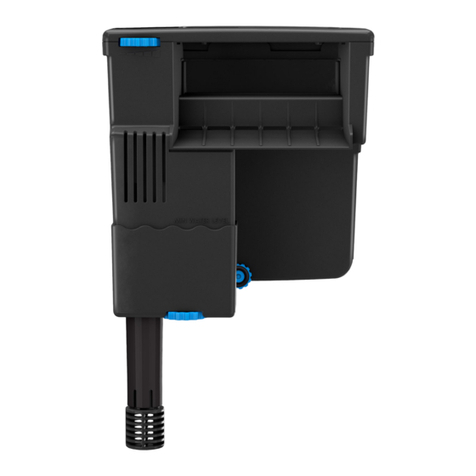
Sicce
Sicce Tidal 55 owner's manual
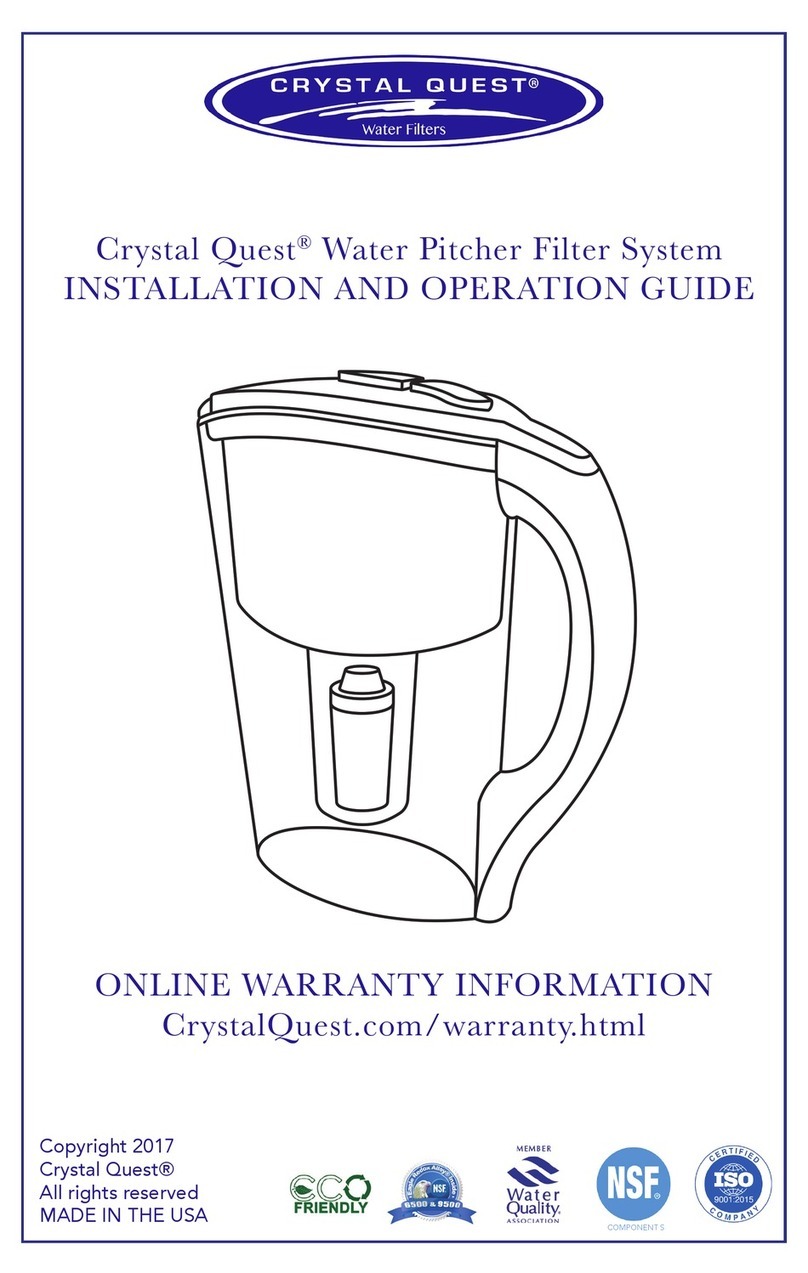
Crystal Quest
Crystal Quest CQE-PI-00601 Installation and operation guide

Sun Water Systems
Sun Water Systems Aquasana RHINO EQ-300 quick start guide
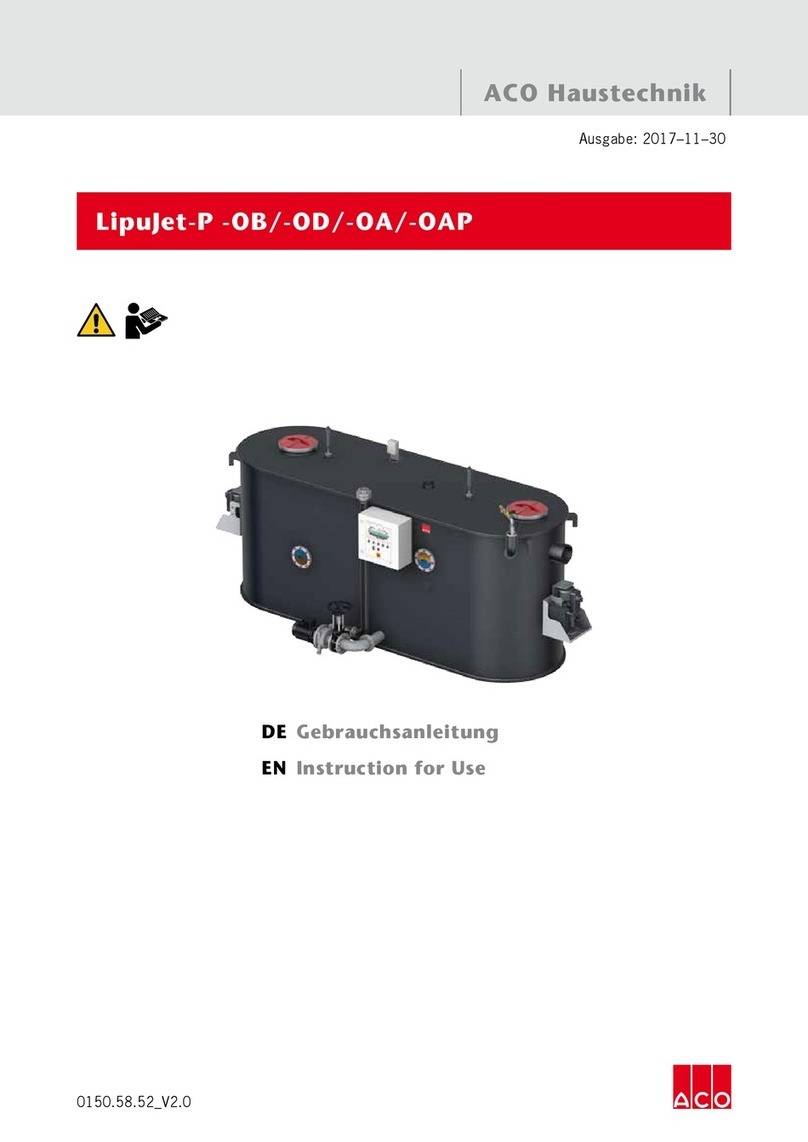
ACO
ACO LipuJet-P Instructions for use

Life Ionizers
Life Ionizers Next Generation M9 user manual



